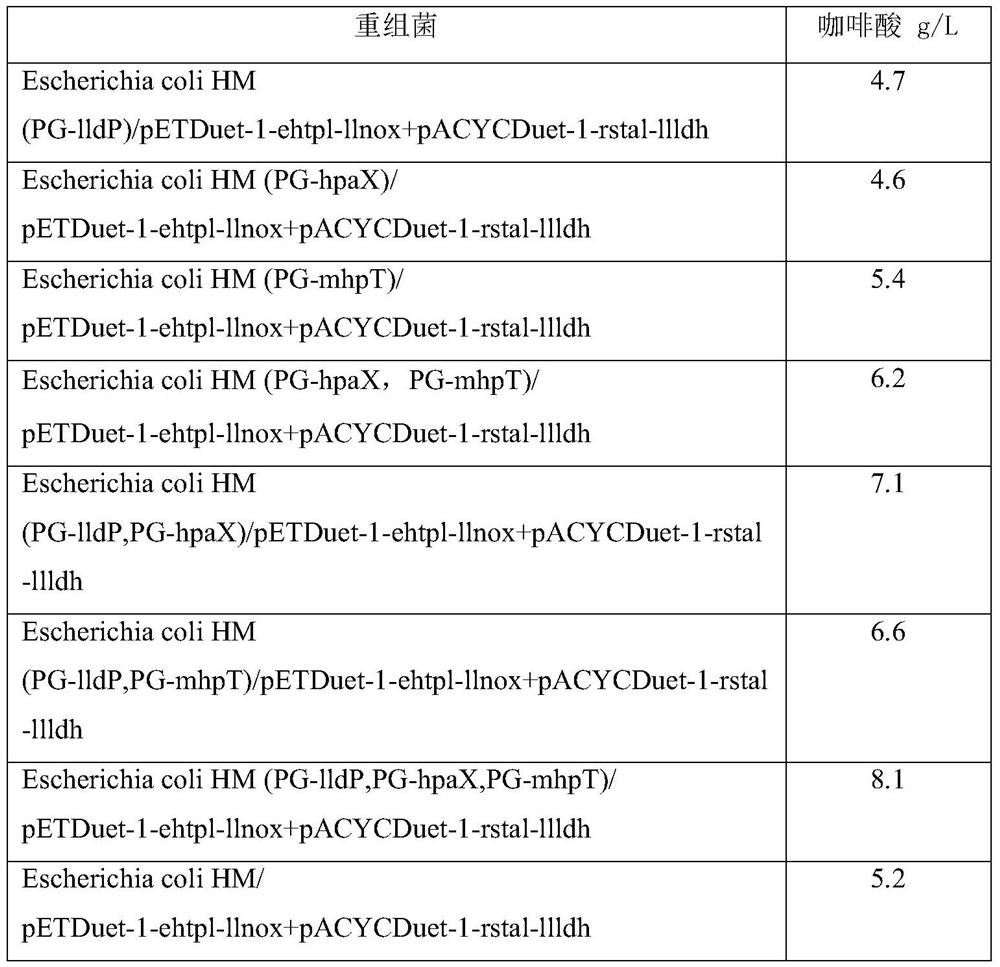A kind of engineering bacteria and its application in producing caffeic acid
A technology of caffeic acid and strain, applied in the field of bioengineering, can solve the problems of easy decomposition, low yield of caffeic acid, high price of dopa, etc.
- Summary
- Abstract
- Description
- Claims
- Application Information
AI Technical Summary
Problems solved by technology
Method used
Image
Examples
Embodiment 1
[0065] According to the method described in the literature Large scale validation of an efficient CRISPR / Cas-based multigene editing protocol in Escherichia coli. Microbial Cell Factories, 2017, 16(1):68, hpaD and mhpB on Escherichia coli BL21(DE3) were single-sampled or double knockout. Wherein, the gene knockout plasmid used in the present invention is pCasRed and pCRISPR-gDNA (hpaD sgRNA) and homology arm (hpaDdonor) together into Escherichia coli BL21 (DE3), Cas9 / sgRNA induces the host to produce double-stranded at the hpaD gene site Fragmentation, recombinase Red integrates the hpaD donor into the hpaD gene to achieve gene knockout, and sequence verification. hpaD sgRNA, hpaD donor, mhpB sgRNA, mhpB donor are shown in SEQ ID NO: 10, SEQ ID NO: 11, SEQ ID NO: 12, and SEQ ID NO: 13 in the sequence table, respectively. mhpB was knocked out in the same way.
[0066] A solution with a pH of 8, 2 g / L of catechol or caffeic acid, 100 g / L of wet bacterial mass, was placed at 35...
Embodiment 2
[0071] Construction of recombinant Escherichia coli: First, the genes encoding tyrosine phenol lyase, tyrosine ammonia lyase, NADH oxidase and L-lactate dehydrogenase were ligated into pETDuet-1 or pACYCDuet-1 plasmids, respectively. Two double-gene co-expression recombinant plasmids were obtained, and the two plasmids were transformed into Escherichia coli HM, and positive transformants were obtained by screening with chloramphenicol and ampicillin plates, that is, recombinant Escherichia coli was obtained.
[0072] Induction expression method: The recombinant Escherichia coli was transferred to LB fermentation medium (10g / L of peptone, 5g / L of yeast powder, 10g / L of NaCl) according to the volume ratio of 2%. 600 After reaching 0.6-0.8, IPTG with a final concentration of 0.4 mM was added to induce expression and culture at 20°C for 8 h. After induction of expression, cells were collected by centrifugation at 20°C, 8000 rpm, and 20 minutes.
[0073] After the recombinant Esch...
Embodiment 3
[0077]Using the method described in the literature Large scale validation of an efficient CRISPR / Cas-based multigene editing protocol in Escherichia coli. Microbial Cell Factories, 2017, 16(1): 68, the corresponding genes on the Escherichia coli HM genome were increased in front of Escherichia coli A moderate expression strength constitutive promoter (PG) in front of the glyceraldehyde-3-phosphate dehydrogenase gene (gpdA), the sequence is shown in SEQ ID NO:9.
[0078] When the expression of the gene lldP was enhanced, the Escherichia coli HM genome was used as the template, and the primers lldP-FF / lldP-FR, lldP-gpdA-F / lldP-gpdA-R, lldP-RF / lldP-RR were used to amplify the upstream and start 11dP-FF and lldP-RR were used as primers to fuse into an expression cassette containing the gpdA promoter. Then, together with plasmid pCasRed and pCRISPR-gDNA (containing lldP sgRNA) into Escherichia coli HM, Cas9 / sgRNA induces the host to have double-strand breaks at the lldP gene ...
PUM
 Login to View More
Login to View More Abstract
Description
Claims
Application Information
 Login to View More
Login to View More - R&D
- Intellectual Property
- Life Sciences
- Materials
- Tech Scout
- Unparalleled Data Quality
- Higher Quality Content
- 60% Fewer Hallucinations
Browse by: Latest US Patents, China's latest patents, Technical Efficacy Thesaurus, Application Domain, Technology Topic, Popular Technical Reports.
© 2025 PatSnap. All rights reserved.Legal|Privacy policy|Modern Slavery Act Transparency Statement|Sitemap|About US| Contact US: help@patsnap.com


